Back in the
day before television and computer
games, every kid was outside
playing baseball. The growing
demand for baseball bats increased
with the popularity of our national
pastime. To generate extra income,
most small woodworking companies
produced baseball bats. Some became
subsidiary companies to the larger
sporting good manufacturers, to
relieve the increasing workload,
and they would also produced their
own brand. Small sporting good
stores, mail order companies,
discount, and hardware stores that
carried sporting goods would also
have privately branded bats
produced for them, resulting in
100's of privately branded bat
labels.
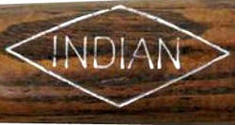
Some labels such as with this
Indian brand baseball bat are
difficult to trace back, because of
the lack of a company name or
business location. These type of
branded labels are usually
associated with discount store, bat
& ball sets. A newspaper adverting
circular would be needed to
identify the bat, and more than
likely found by chance.
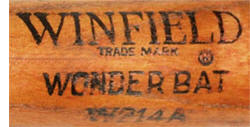
In the case of this
Winfield Brand baseball bat,
which also lacks company
information, the registered
trademark will lead to an ID.
Winfield was a line of Juvenile,
toy and discount store quality
baseball equipment carried by the
"Five-and-Dimes" variety store F.
W. Woolworth Company. The in-store
brand was taken from the founder,
Frank Winfield Woolworth's middle
name. The Winfield bats were part
of a "Junior Baseball Set" that
also included a baseball & glove.
The bats range in size from about
22" to 30," in length, and the
longer bats might have been sold
separately.
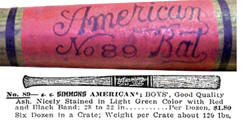
The
American Bat No. 89, and No. 35
baseball bats do not have company
information, location, or
trademarks branded on them. The
American bat No. 89, is mentioned
in a 1909 newspaper advertisement
and is also listed in
E.C. Simmons
catalogs around the same time
frame. 'Simmons American' was a
trademark in-store brand name for
sporting goods that the hardware
company carried.

There are no catalogs or
advertising available to use to
confirm that the No. 35 bats were
made by the same company. Both bats
have the same "American Bat" ornate
branding. The No. 35 with slight
differences, has similar ornate
branding, and might be dated later
or to another company that started
up in 1939. In 1939 there was a
small company named the American
Bat Company that was started up in
Woodburn, Oregon. The company was
short lived, and closed by 1943.

Headquartered in Sheboygan Falls,
Wisconsin the
Bemis Manufacturing Company
dates back to 1901. The company
manufactured toilet seats, molded
wood products and wood dimensions.
In 1965 the company opened up a
woodworking plant in Crandon, WI
where they made items such as
Bowling pins, parts for sleds,
croquet balls, and baseball bats.

The patented Hickory Stick was the
result of extensive research by
Bemis' engineering staff, the U.S.
Forest Products Laboratory and the
University of Wisconsin baseball
coach Art Mansfiels. Composed of
five pieces of hickory wood, the
Laminated baseball bat was used on
an experimental basis at the
University of Wisconsin at the
start of the 1965 season. Laminated
equipment was outlawed in
professional baseball and
previsions in the college rules
allowed laminated bats.

Joe Engel pitched for the
Washington Senators, from 1912-15,
and 1920. He became one of the most
successful scouts in history, a
promoter and team owner of the
Chattanooga Lookouts. In 1951 Engel
recruited the expertise of Garnett
Beck, and formed the
Joe Engle Bat
Co. in Chattanooga, Tennessee.
Garnett Beck was a bat maker, and
owner of the Superior bat Co. In
1930 Garnett Beck sold a patent for
$1,000., to the Hillerich & Bradsby
Co. to strengthen bats with a glue
process. The next ten years Garnett
worked as a foreman for Louisville
Slugger.

The
Superior Bat company was
started up in 1920 by Garnett Beck,
brother of Zinn Beck, a major
League ball player that played with
the St. Louis Cardinals, from
1913-1916, and the New York Yankees
in 1918. The brothers opened a
factory in Columbia, South
Carolina, where Zinn was playing in
the minor leagues from 1920-1925,
and Garnett started turning out
laminated bats. In 1923 the Zinn
Beck Bat Company moved to
Greenville.

The
Zinn Beck Bat Company
was
established in 1920 by Zinn Beck.
From 1920 to 1922, Beck managed the
Columbia Comers in Columbia, and
from 1923 to 1925 Beck managed the
Greenville Spinners in Greenville,
South Carolina. The brothers opened
a factory in Columbia, South
Carolina, in 1920. In 1922 the
company became a corporation, then
moved to Greenville, SC, in 1923.
The Zinn Beck Bat Co. which was
producing 3,000 bats a day, was
sold to Zenas C Grier for about
$50,000., in 1927. The name was
then changed to Grier Mfg Co.
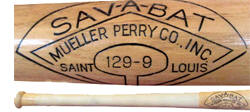
Inventors Alvin W. Mueller and Lyle
R Perry, co-founded the Muellen
Perry Co. in 1959. Mueller worked
for the McDonnell Douglas Co. for
many years, and had been a
minor-leaguer with the Yankees. His
son Jim, played in the Chicago
White Sox minor-league system from
1969-1970. In 1959 "SAV-A-BAT"
became a trademark for the Mueller
Perry Co Inc. The company filed for
a patent in 1960, for a
reinforcement that can be applied
to a bat handle to strengthen it.
The Patent was approved in 1964,
but the company began to market the
product in 1961.
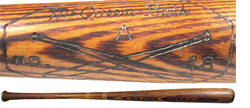
Clayton
E. McQueen was the proprietor of a
woodworking plant in Belmont, NY
from 1927-1961. Select timber made
into billets would then be turned
into baseball bats which would find
their way into the hands of such
greats as Lou Gehrig, or Hank
Greenberg. Following the
preliminary process the billets
were shipped to the Kren Bat
Company factory in Syracuse.
A large
portion Kren's stock came from
McQueen's plant in Belmont.


